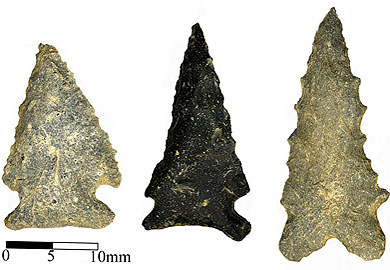DNR News
** Archived Article - please check for current information. **
Feb. 6, 2014
Archaeological excavations open at Great Pee Dee March 10
The 17th Annual Johannes Kolb Archaeology and Education Project will be March 10-15 and March 17-21 at Great Pee Dee Heritage Preserve, a 2,725-acre preserve in Darlington County owned and managed by the S.C. Department of Natural Resources.
On Saturday, March 15, from 9 a. m. to 4 p.m., the public is invited to tour the excavations at the Johannes Kolb Site. There will be a host of demonstrators at the site for the March 15 public day. Numerous time periods when people lived at the Kolb site will be represented including: 18th century Native Americans and European colonists; late 19th century African-American sharecroppers; and demonstrations of primitive skills (stone tools, friction fire and aboriginal cookery).
Excavations will take place at the site on March 10-15, 17-21. Someone will be on site every day from 9 a.m. until 4 p.m. to talk with students and visitors. School groups wishing to visit may contact Sean Taylor, S.C. Department of Natural Resources (DNR) Heritage Trust archaeologist, at (803) 734-3753 in Columbia or by e-mail at TaylorS@dnr.sc.gov. 
More than 90 percent of the Native American artifacts excavated from the Kolb Site are the discarded by-products, i.e. flakes, of the stone tool-making process. Many of the historic artifacts represent the mundane day-to-day activities of making a living from the river swamp. Both are equally important to our understanding of what life was like for people who lived along the Great Pee Dee River for the last 12,000 years. However, these artifacts are not as exciting as those occasional pieces that represent the people who called the Kolb site home.
A multi-component prehistoric site is present on the preserve with Native American remains from Paleoindian (11,000 years ago), Early Archaic (10,000 to 8,000 years ago), Early Woodland (4,000 to 2,000 years ago) and later Woodland times (2,500 to 1,500 years ago). The 2010 season saw the completion of the excavation of a cellar feature thought to be related to the early 20th century saw mill and loggers camp at the Kolb site. Thoms Creek pottery, from the Early Woodland period, has been found on the site, and a sizable fragment was recovered in 2004. Thoms Creek is some of the earliest Indian-made clay pottery in the continental United States. In 1998, a Hardaway Point dating back 11,000 years was discovered at the Great Pee Dee Heritage Preserve, and in 2000 a portion of a 12,000-year-old Clovis Point was found.
Artifacts from the 19th century, such as broken glass, bricks and nails, have also been found on the preserve. In total, more than 200,000 artifacts have been recorded at the site in the past years of fieldwork. Chip Helms of Darlington, a past member of the S.C. Institute of Archaeology and Anthropology's Archaeological Research Trust Board, first recorded this site and others on the preserve in 1975. Helms, who has explored the preserve since he was a young boy, has been the driving force behind the current excavations.
More News
